YOU SHOULD SUBSCRIBE TO CLIMATE CHANGE WEEKLY.
IN THIS ISSUE:
- Biden Climate, Energy Policies’ Costs: High and Rising
- Podcast of the Week: No, Virginia, a Climate Catastrophe Is Not Really 10 Years Away! (Guest: Kenneth Green)
- China’s Great Leap Forward With Nuclear
- Media Ignores Declining Temperature Anomaly
- Biomass Is Not Green, S&P Says
- Climate Comedy
- Video of the Week: Authoritarianism in the Climate Change Debate
- BONUS Video of the Week: The Trajectory of Electrical Power Generation
- Recommended Sites
Biden Climate, Energy Policies’ Costs: High and Rising
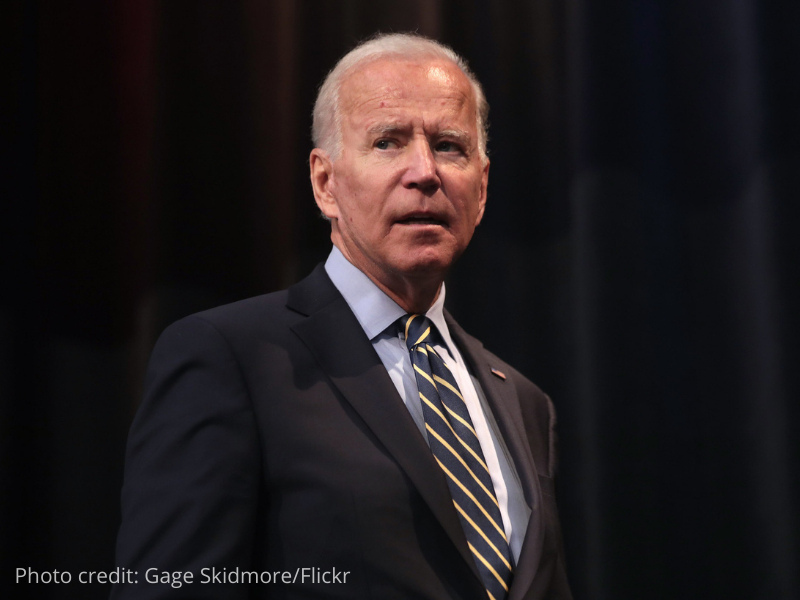
In Climate Change Weekly 419, I detailed some of the policies Joe Biden has imposed as president that have contributed to higher energy prices and the inflation affecting other goods and services now plaguing average American households.
“[Climate change is] the number one issue facing humanity. And it’s the number one issue for me,” said Biden.
Among the steps Biden has taken to fight climate change: he cancelled the Keystone XL pipeline partnership with Canada, on his first day in office, possibly the first time in history a president used his first day in office to kill thousands of American jobs and disrupt critical infrastructure; shortly thereafter, Biden imposed a moratorium on new oil and gas leases on federal lands and on the U.S. outer-continental shelf. Since then, Biden has cancelled oil and gas leases in the Arctic National Wildlife Refuge; proposed methane emission restrictions that would make it harder and more expensive to develop, store, and transport oil and natural gas in the United States; proposed increasing the fees and royalty rate oil and gas producers must pay the federal government; and recently announced plans to foreclose drilling on more than half of the National Petroleum Reserve-Alaska.
Biden’s efforts to fight climate change by hammering U.S. production of fossil fuels have resulted in dramatically higher fuel and food prices. Energy is the master resource, the lifeblood of the economy. Energy abundance and the low prices it brings create jobs and keep the economy humming. Biden has ignored this fact to the detriment of consumers, employers, homeowners, and, importantly to his party’s sinking electoral prospects, voters.
How bad is it? How much have energy prices risen since Biden entered office and started waging his war on domestic energy? My colleague at The Heartland Institute, energy and environment Research Fellow Linnea Lueken, has crunched the numbers for a forthcoming Heartland Institute publication. This is what she found during Biden’s first year in office:
- Residential electricity prices rose 11.3 percent.
- Natural gas prices rose 86.34 percent.
- Regular gasoline prices have risen by 42 percent and diesel rose by 38.9 percent.
These are just the current, known results of Biden’s energy policies. When one recalls Biden has pledged to implement policies to reach 100 percent “carbon” pollution-free electricity by 2035 and to reach net-zero emissions nationally by 2050, it is obvious these higher prices are just a small down payment on Biden’s ultimate energy plans.
While running for president, Biden claimed his comprehensive climate and energy plans would cost $2 trillion in just four years. As high as this figure is— equivalent to five times the amount that consumers and industry currently spend annually on electricity—it pales in comparison with estimates recently calculated by the consulting firm McKinsey & Company.
McKinsey’s report, “The Net Zero Transition,” provides a detailed analysis of the costs involved in hitting net zero by 2050.
The report states the economic cost of the transition will be a staggering $275 trillion by 2050, or approximately $30 billion per day for the next 25 years. With an almost laughable degree of understatement, the McKinsey reports states, “our estimates of the annual spending on physical assets for a net-zero transition exceed to a meaningful degree the $3 trillion–$4.5 trillion total spending estimates that previous analyses have produced.”
As high as these figures are, McKinsey admits its analysis is not comprehensive:
In particular it does not focus on such issues as technology breakthroughs, physical constraints related to scale-up capacity and the availability of natural resources, delayed-transition costs, the role of adaptation, or other imponderables or uncertainties, nor have we yet modeled the full range of economic outcomes likely under a net-zero transition. As a result, it is likely that real outcomes will diverge from these estimates, particularly if the net-zero transition takes a more disorderly path or restricting warming to 1.5°C proves unachievable. Spending requirements could be higher, for example due to the additional investment needed to maintain flexibility and redundancy in energy systems, or heightened physical risks and commensurate adaptation costs.
Nor does McKinsey’s report address the kinds of political losses that, based on past experience, one should expect to occur in the process of implementing a large-scale makeover of the energy system underpinning the economy, via special-interest lobbying and the operation of government itself. For every significant policy change, those who expect to be harmed or disadvantaged and those who expect to benefit from or be advantaged by it devote massive amounts of money and resources to shape the legislation as much as possible in their favor. In addition, significant money, resources, and manpower are diverted to government agencies to establish rules and mandates for the transition, monitor its implementation and measure its results, and police the programs and punish lawbreakers.
Losses to transaction costs are high for every significant piece of legislation. How much higher will they be for the kind of comprehensive, economy-wide redesign necessary to reach net zero?
To some degree, McKinsey’s analysis presents a best-case scenario: the costs of hitting net zero will be $275 trillion by 2050 “if all goes right, the transition is smooth with no unexpected technological failures or resource shortages, no cheating, and government operations are efficient.”
McKinsey writes,
The net-zero equation remains unsolved…, nor is the world prepared to complete the net-zero transition. … Nor would execution be easy: solving the net-zero equation cannot be divorced from pursuing economic development and inclusive growth. … It could also have knock-on impacts on the economy more broadly, potentially creating a backlash that would slow down the transition. …
Achieving net zero would mean a fundamental transformation of the world economy, as it would require significant changes to the seven energy and land-use systems that produce the world’s emissions: power, industry, mobility, buildings, agriculture, forestry and other land use, and waste.
Is that all we’d have to do?
Even this dramatic economic overhaul may not be enough to prevent the supposed climate crisis.
“First, it is not clear whether a 1.5°C scenario is achievable in the first place, nor what pathway the world would take to achieve it if it were,” writes McKinsey. “Indeed, even if all net-zero commitments and national climate pledges were fulfilled, research suggests that warming would not be held to 1.5°C above preindustrial levels….”
A forced economic transition greater than any in history, at costs exceeding any in history and far above what has been previously estimated; that’s what net zero requires. Even so, the result is likely to be for naught, with the dreaded 1.5℃ temperature rise still exceeded.
The good news is that the massive forced transition to net zero is not necessary, even if it were possible and governments and industries could be relied on to carry it out efficiently and without corruption.
As shown in the myriad fact sheets provided at Climate at a Glance, extreme weather is becoming neither more common nor more severe, and a modest 1.5℃ temperature rise does not threaten to destroy either human civilization or the Earth. The Earth abides, and humans have lived through more severe and dire climate changes in the past than any that could reasonably be expected to result from rising greenhouse gas emissions in the future.
SOURCES: Climate Change Weekly; Climate Realism; Forbes; McKinsey & Company
Check Out All Our Presentations in Scotland
Podcast of the Week
Climate alarmists mistake computer models for reality. Real-world data shows there is no looming climate catastrophe just 10 years off. The alarmists’ insistence that we’re facing a climate apocalypse is nothing more than a ploy for power.
Their predictions, like the computer models they are based upon, are consistently wrong. Scientists now realize that the climate is more variable than previously believed. Responding to climate change isn’t about humanity changing the weather. It’s about adapting to natural climate shifts. Society can adapt to, and capitalize on, the changing climate.
China’s Great Leap Forward With Nuclear
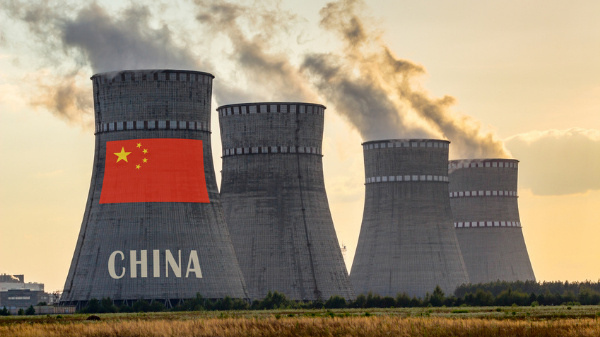
China is taking the lead on new nuclear energy technologies, leaving the United States and other countries lagging while burnishing its climate leadership credentials.
Reuters reports the state-owned China National Nuclear Corporation (CNNC) launched the first commercially active high-temperature gas-cooled “pebble bed reactor” (PBR) nuclear power plant in the eastern coastal province of Shandong.
The CNNC connected the 200 megawatt Shidaowan reactor to the grid in mid-January. A second unit is under construction.
“In PBR technology, the reactor core is formed from graphite pebbles that contain specially designed fuel particles,” explains Reuters. “The design allows reactors to be run safely at higher temperatures, CNNC said, describing it as ‘the reactor that won’t melt down.’”
The reactor, 93.4 percent of which was sourced domestically, is one of six the CNNC has proposed to construct over the next decade.
In addition to introducing the first PBR into commercial operation, China has also constructed a new, nuclear-power-driven heating design in Shandong. The project extracts the residual steam under high pressure from the nuclear power unit as a heat source, and after going through a multistage heat exchange through the power station, transfers the heat to residential homes through the municipal heating pipeline network.
According to the Global Times, China claims this co-generation project, along with similar projects being developed around the nation, will improve the use efficiency of power plants and help the country achieve its strategic goals of “carbon peak and carbon neutrality.” The recent co-generation project replaced 12 local coal-fired water boilers, providing non-carbon-dioxide-emitting heat to 200,000 residents in Haiyang. China claims this makes Shandong the first “zero carbon” residential heating city in China.
SOURCES: Reuters, Global Times
Heartland’s Must-read Climate Sites
Media Ignores Declining Temperature Anomaly

An analysis of the National Oceanic and Atmospheric Administration’s (NOAA) year-end global climate report published on Watts Up With That shows NOAA’s report hides more than it reveals. NOAA claims the 2021 global temperature anomaly was the sixth-highest of its recorded measurements.
“The year culminated as the sixth warmest year on record for the globe with a temperature that was 0.84°C (1.51°F) above the 20th century average,” NOAA states. “The years 2013–2021 all rank among the ten warmest years on record.”
Analyst Larry Hamlin points out NOAA downplayed the fact that the 2021 global temperature anomaly measurement marked the sixth year of decline in the temperature anomaly. The decline has persisted despite a measured increase in atmospheric carbon dioxide concentrations.
The six-year temperature anomaly decline measured by NOAA is confirmed by the temperature anomaly data sets provided by NASA, the UK Met Office, the University of Alabama at Huntsville, and the Remote Sensing System analysis (see the graphs below). Every major temperature measuring system relied upon by alarmists to proclaim unprecedented warming is in the offing, threatening a climate emergency, has displayed a declining trend in the temperature anomaly over the past six years. This data is in stark contrast with the consistent upward trend projected by the climate models used by the Intergovernmental Panel on Climate Change. This declining trend has occurred even as atmospheric carbon dioxide concentrations grew from 402 ppm to 417 ppm as measured at the Mauna Loa Observatory.
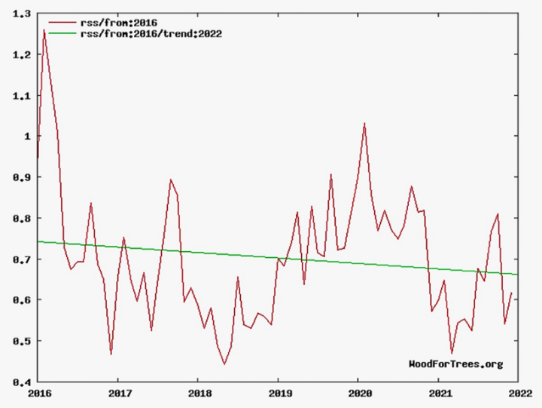

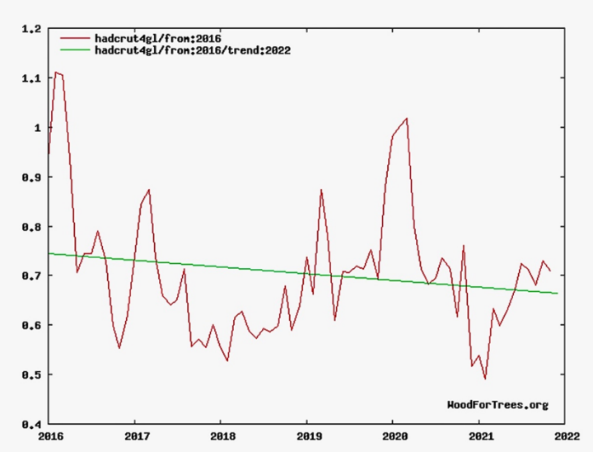
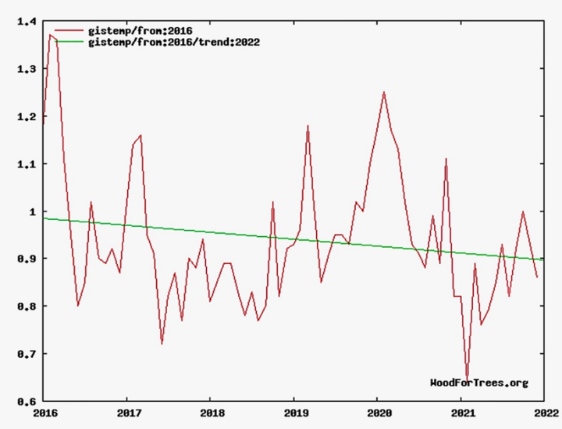
After examining NOAA’s monthly data closely, Hamlin concludes it “clearly establishes that the monthly and annual global temperature anomaly measurement behaviors are strongly controlled by El Niño and La [Niña] events which are naturally occurring climate phenomena and not driven by man made contributions to atmospheric CO2 levels.”
If Hamlin is correct, natural cycles, not human greenhouse gas emissions, have dominated global temperature trends for the past six years at least. If this is true for the past six years, why not think, as many scientists have suggested, nature has been in control across the whole past 150 years, during which the Earth has experienced alternate periods of warming, cooling, warming, relative stasis, warming, and now cooling again?
SOURCE: Watts Up With That
Biomass Is Not Green, S&P Says

The S&P Global Clean Energy Index removed British energy giant Drax from its portfolio after it determined the company wasn’t producing carbon-neutral or clean energy.
The Drax group, which produces 5 percent of the electric power used in the United Kingdom, vowed to become the world’s first carbon-negative energy company by 2030. Drax’s promise was to be met through its operation of power plants burning wood pellets to replace coal in generating electricity. Drax has already converted four of six electricity generating units from coal to wood pellets.
Drax is not the first biomass-burning energy company S&P booted from its Global Green Energy Index. It had previously removed French biomass burner Albioma from the list.
Numerous studies show burning biomass is neither green nor clean.
“Biomass generally benefits from confusion over two vastly different terms that often are used interchangeably: ‘renewable’ (or sustainable) and ‘carbon free,’” writes science journalist Michael Fumento in The American Conservative. “Both appeal to the touchy-feely, warm and fuzzy set, but they are not necessarily the same.”
Although biomass can be renewable, burning it is not carbon neutral.
Research shows biomass burning often produces as much or more of traditional regulated air pollutants as coal while wiping out thousands of acres of wildlife habitat. In addition, the claimed carbon dioxide neutrality is vitiated by the emissions from creating the pellets from virgin wood and scrap material, shipping it from overseas, and, most importantly, because even when trees are planted to replace those harvested to burn in power plants (and they aren’t always), any emissions removed happen over decades if not centuries, whereas the emissions from burning the wood pellets are produced immediately.
In the here and now, biomass burning emits “65 percent more carbon dioxide per megawatt hour than modern coal plants and an amazing 285 percent more carbon dioxide than natural gas combined-cycle power plants,” writes Fumento.
A study published in Environmental Research Letters calculated the payback time for forests in the eastern United States, where most of the biomass burned by Drax and others comes from. Under the best-case scenario—when all harvested land is reforested and is allowed to regrow to maturity—burning wood pellets creates a carbon deficit, carrying a payback time of between 44 and 104 years.
SOURCES: The American Conservative; The Guardian; Physics World
Video of the Week: Authoritarianism in the Climate Change Debate
The climate change debate is not a fair fight. Authoritarianism reigns throughout the alarmist side, often silencing climate realists before they have a chance to speak.
Andy Singer, Linnea Lueken, Anthony Watts, and Sterling Burnett discuss how climate alarmism is dominated by authoritarian voices on this week’s Climate Change Roundtable.
BONUS Video of the Week: The Trajectory of Electrical Power Generation
Marty Cornell gives a brief presentation on the panel The Right Climate Stuff: Texas Freeze, Nuclear Energy, and the Path Forward at The Heartland Institute’s 14th International Conference on Climate Change.
Climate Comedy



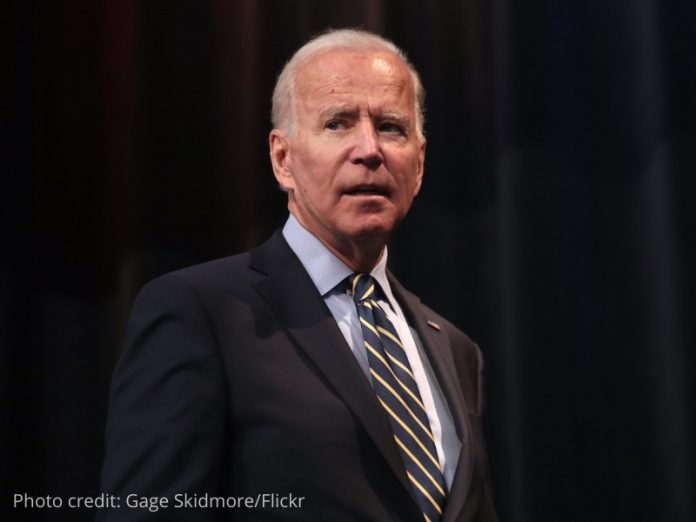



























[…] From Heartland Daily News […]
[…] From Heartland Daily News […]
[…] From Heartland Daily News […]
[…] 하트랜드 데일리 뉴스에서 […]
[…] From Heartland Daily News […]
[…] From Heartland Daily News […]
[…] From Heartland Daily News […]
[…] https://heartlanddailynews.com/2022/02/climate-change-weekly-424-biden-climate-energy-policies-costs…, darin der zweite […]
[…] https://heartlanddailynews.com/2022/02/climate-change-weekly-424-biden-climate-energy-policies-costs…, darin der zweite […]
[…] https://heartlanddailynews.com/2022/02/climate-change-weekly-424-biden-climate-energy-policies-costs…, darin der zweite […]